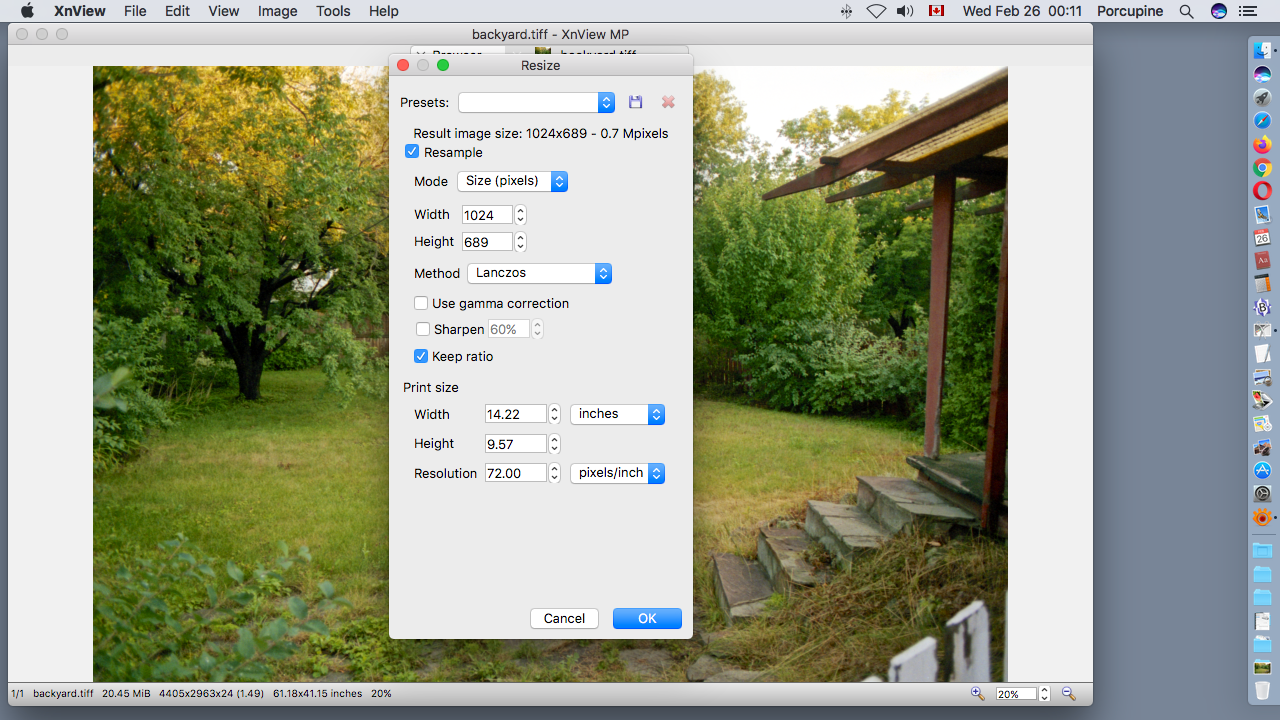

Now we calculate the span of the image in pixels is 12.5 ÷ 0.00389 = 3214 pixels (rounded up). Suppose the center-to-center pixel spacing is 3.89 µm (micrometers), 0.00389mm. The span of the projected image will be 50 X 0.250 = 12.5mm.įrom the camera specification sheet, we can discover the pixel pitch. The image will display exactly the same on screen regardless of the number you have in the Resolution field. For screen viewing it is irrelevant, the only important numbers are the pixel dimensions. Suppose the camera’s zoom lens was set to 50mm (or a prime 50mm was used). Ppi is metadata that is used to calculate print size. This will be the focal length of the lens at the time the picture was taken. Likely, of the two, the projection distance is the most easily discoverable. If one of these values is known, the other is easily calculated. In other words, the projection distance inside the camera and the image size yield the same ratio. Inside the camera, the image forming rays from the lens, trace out the same ratio as they travel. The ratio size-to-distance is 3÷ 12 = 0.250.
Say a object is 3 meters wide and a picture is taken with the camera positioned 12 meters from the subject. originalImage.If you know the actual width or height and camera-to-object distant, you can easily calculate a ratio size-to-distance.
Iresize in pixels method width code#
We will modify this code later to be a callable function so that the width is no longer hard-coded and the height can be set arbitrarily when users don't want to preserve the aspect ratio. We can use the following JavaScript code to resize our image. Let's say we want to resize the puppy image so that it's only 500 pixels wide. This means that we can get the whole image by setting the values of sx, sy, sWidth, and sHeight to 0, 0, the image width, and the image height respectively. The top-left corner of the image is considered to be (0, 0), and the bottom-right corner corresponds to ( imageWidth, imageHeight). I have marked the source values on the puppy image from Pixabay that we will be cropping to give you an idea of what these parameters signify. Similarly, sWidth/ sHeight and dWidth/ dHeight represent the width and height of the images. This means that (sx, sy) and (dx, dy) represent the top-left coordinate of the images. The prefixes s and d signify the source and destination for our original and new image. The first parameter is the image element that you want to draw on the canvas. We will be using the second version for our resizing functionality and the third version to implement cropping. Void ctx.drawImage(image, sx, sy, sWidth, sHeight, dx, dy, dWidth, dHeight) Void ctx.drawImage(image, dx, dy, dWidth, dHeight) It can accept three, five, or nine parameters and has the following syntax. We can use it to resize and crop our images by passing an appropriate number of arguments. The drawImage() method of the canvas API will have an important role to play here.

Having access to the aspect ratio will allow us to resize the image without stretching it in either direction, so that we can avoid any distortion. This width and height are used to determine the aspect ratio of the image. We will now use an event listener to wait for the image to load and then get its original width and height. Here is an example: // Referencing an Image loaded in the DOMĬonst originalImage = document.querySelector("img.puppy") You can do that either by referencing an image that has already been loaded in the DOM or by creating a new image using the Image() constructor. The first thing that we need to do is load our image data. One thing that you should keep in mind is that getting access to the image data for manipulating it with a canvas requires you to either have the image on the same server or use the crossorigin attribute to indicate that the canvas has permission to access, modify, and save the image data. We will use the API in this tutorial to create our cropped and resized images. There are hundreds of libraries out there that you can use to create graphs, vectors, and animations using the canvas API. The canvas HTML element has been around for a long time now, and we can use it to draw all sorts of graphics. We can do that with the help of the canvas element. We will need access to the original image data in order to create a new version of the image that is cropped or resized to specific dimensions.

Here's a live demo of our image cropping code in action.Īnd here's an example of the resizing code:
Iresize in pixels method width how to#
In this tutorial, you will learn how to crop or resize an image with JavaScript. We've already published a couple of tutorials on how to create image thumbnails using PHP or apply cropping, resizing and other filters using PHP. What if you want to create an actual cropped or resized version of an image for your visitors or clients? However, this doesn't change the original image data. It's very easy to show a resized or cropped version of an image on a website using CSS.


 0 kommentar(er)
0 kommentar(er)
